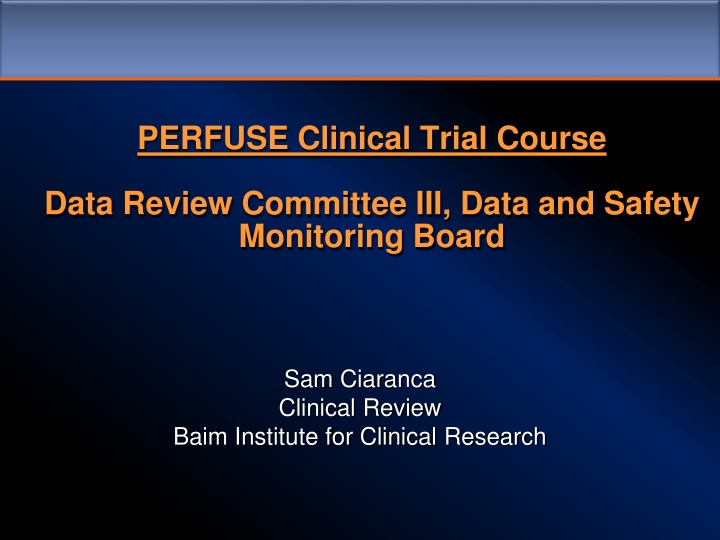Insights into Data Safety Monitoring Boards in Clinical Trials
Data Safety Monitoring Boards (DSMBs) play a crucial role in ensuring patient safety and unbiased data review during clinical trials. This article delves into the history, responsibilities, and format of DSMBs, highlighting their importance in safeguarding the integrity of clinical research.
Download Presentation

Please find below an Image/Link to download the presentation.
The content on the website is provided AS IS for your information and personal use only. It may not be sold, licensed, or shared on other websites without obtaining consent from the author.If you encounter any issues during the download, it is possible that the publisher has removed the file from their server.
You are allowed to download the files provided on this website for personal or commercial use, subject to the condition that they are used lawfully. All files are the property of their respective owners.
The content on the website is provided AS IS for your information and personal use only. It may not be sold, licensed, or shared on other websites without obtaining consent from the author.
E N D
Presentation Transcript
PERFUSE Clinical Trial Course Data Review Committee III, Data and Safety Monitoring Board Sam Ciaranca Clinical Review Baim Institute for Clinical Research
Agenda Purpose of Data and Safety Monitoring Board (DSMB) Brief History DSMB Format DSMB Responsibilities Sponsor Responsibilities Differences regarding CEC/DMAC Where is a DSMB applicable? DSMB Recommendations Example of DSMB Action
Data Safety Monitoring Board A Data Safety Monitoring Board (DSMB), a.k.a Data Monitoring Committee (DMC), is a panel of experts in their respective fields of medicine that regularly reviews aggregate safety and efficacy data from an active clinical trial The goal of the DSMB is to ensure patient safety in an unbiased manner, typically through the duration of trial enrollment DSMB Chair, Members Experience in fields related to the clinical area of study
History 1960s: Basic DSMBs emerge as an element to large, multi- center federally-funded trials with objectives of increased survivability and major morbidity reduction National Institute of Health (NIH), Department of Veterans Affairs (VA) 1967: External Advisory Group recommends the creation of a formal committee to review safety, efficacy, and trial conduct to the National Heart Institute (NHI) Why not an in-house committee?
History 1992: NIH workshop comprised of experts in clinical research began to discuss and dictate the fundamental aspects and general formatting of DSMBs DSMBs became more common and standardized due to: Increased collaboration between the federal government and industry A greater number of higher risk trials with mortality concerns or major morbidity endpoints General awareness of clinical trial conduct resulting in possibly biased results Institutional Review Boards (IRB) had concerns regarding regular trial oversight
DSMB Format FDA recommendations do not provision for any one, specific format of DSMB Average, minimum quorum of 4 members Chair, Members, Biostatistician Facilitation Team No Conflicts of Interest (COI)
DSMB Format Open & Closed Sessions Meeting Minutes Action Items Letter Recommendation Letter DSMB Charter Meeting Schedule
DSMB Responsibilities Delineated by DSMB Charter Ensure all randomized patients are followed-up with Review independently prepared data reports Recommendations regarding trial continuation: Continue without modification Continue with modification Study should be put on hold Study should be stopped
Sponsor Responsibilities Sponsor is the organization responsible for the clinical trial and its initiation (21 CFR 50.3(e); 21 CFR 312.3; 21 CFR 812.3(n)), and maintaining Investigational New Drug Application/Investigation Device Exemption (IND/IDE) (21 CFR 312.40(a)(1); 21 CFR 812.40) Must inform investigators and IRBs of any DSMB recommendations Must provide aggregate safety and efficacy data to the DSMB Staff present on Open DSMB Meetings Sponsor is NOT required to accept the DSMB's recommendations
Differences with CEC, DMAC Clinical Events Committees (CEC) adjudicated specific, pre- defined adverse events and help to monitor trial safety on a more focused level than DSMBs CECs also help to generate data for DSMBs to review Data Monitoring and Adjudication Committees (DMAC) are combinations between DSMBs and CECs, both reviewing aggregate safety and efficacy data while adjudicating adverse events DMACs can come about for budgetary or trial size reasons
Trial Phase Reminder https://www.researchgate.net/figure/Characteristics-of-Clinical-Trial-Phases_tbl4_301745695
Applicability Applicable: FDA does not formally require DSMBs for trials except when research is performed in emergency settings where informed consent is excepted, as dictated by 21 CFR 50.24(a)(7)(iv) Most Phase III studies require a DSMB The involvement of a DSMB may still be recommended for low-risk studies if the studies have extenuating circumstances Phase II studies which are "high risk" require a DSMB Clinical trials of diseases with high mortality/morbidity, involving high risks, and large, multicenter clinical trials When futility at interim analysis may ethically require study termination Particularly vulnerable study populations
Applicability Not applicable: Single-center Phase I, II Trials A multicenter, high-risk Phase I with stopping rules Quick, brief trials https://www.concertpharma.com/understanding-clinical-trial-terminology-whats-a-phase-1-2-or-3-clinical-trial/
DSMB Recommendations Review Open and Closed Data Reports in separate meeting sessions Generate action items and vote on a DSMB recommendation Ask questions and engage in discussion Send Sponsor formally replies to recommendation letter and action items FDA contacted to review recommendations, if deemed necessary recommendation letter and action items to Sponsor Recommendation letter contents shared with investigational site staff, including IRBs
Example of DSMB Action A DSMB composed of 1 heart failure specialist, 1 pulmonary vascular disease specialist, 1 interventional cardiologist, 1 cardiologist, and 1 biostatistician work on a trial Trial Design: Multicenter, prospective, randomized controlled, double blinded trial, with a non- implant control group; 1:1 randomization, hundreds of subjects. Patients randomized to the control arm will be allowed to cross-over to the treatment arm at 24 months post-control procedure provided patient selection criteria are met at that time. Control group is provided with standard of care treatment Trial Device: An internal shunt designed to ameliorate symptoms of Heart Failure (HF)
Example of DSMB Action The DSMB reviews the data provided in the Closed Report. Enrollment of subjects has finished. They examine tables displaying event rates in subjects They note that, at 6 months and 1 year, subjects in the study who have received the device experience a greater frequency of Atril Fibrillation (AFib) and Major Adverse Cardiovascular Events (MACE) when compared to the control group to a statistically significant degree Kaplan-Meier Curves for freedom from HF show that subjects who have received the device experience statistically greater HF events DSMB recommends...
Example of DSMB Action The DSMB recommends halting patients crossing over from the control arm to the treatment arm while maintaining the remainder of the study Why maintain study follow-up? Safety and Efficacy data intertwined in this example https://nyulangone.org/news/remarkable-technique-replace-heart-valves-spares-patients-surgery
References 1. Center for, Biologics Evaluation and Research. Establishment and Operation of Clinical Trial Data Monitoring Committees. U.S. Food and Drug Administration, FDA, Mar. 2006, www.fda.gov/regulatory-information/search-fda-guidance-documents/establishment-and- operation-clinical-trial-data-monitoring-committees. 2. Lin, J. Y., & Lu, Y. (2014). Establishing a data monitoring committee for clinical trials. Shanghai archives of psychiatry, 26(1), 54 56. https://doi.org/10.3969/j.issn.1002- 0829.2014.01.009 3. Clinical Trials Transformation Initiative. Data Monitoring Committees: project summary, http://www.ctti-clinicaltrials.org/what-we-do/cttiprojects/dmcs (accessed 23 February 2016). 4. Dental and Craniofacial Research, National Institute of. Data and Safety Monitoring Board (DSMB) Guidelines. National Institute of Dental and Craniofacial Research, U.S. Department of Health and Human Services, July 2018, www.nidcr.nih.gov/research/human-subjects-research/toolkit-and-education- materials/interventional-studies/data-and-safety-monitoring-board-guidelines. 5. School of Medicine, University of North Carolina. When Is a DSMB Needed?, 2021, tracs.unc.edu/index.php/services/regulatory/data-and-safety-monitoring-board/when-is-a- dsmb-needed.























